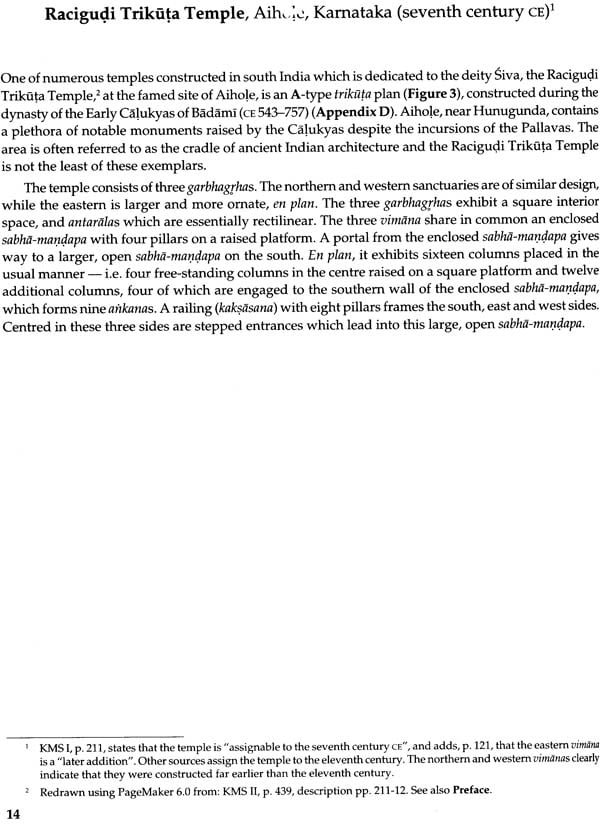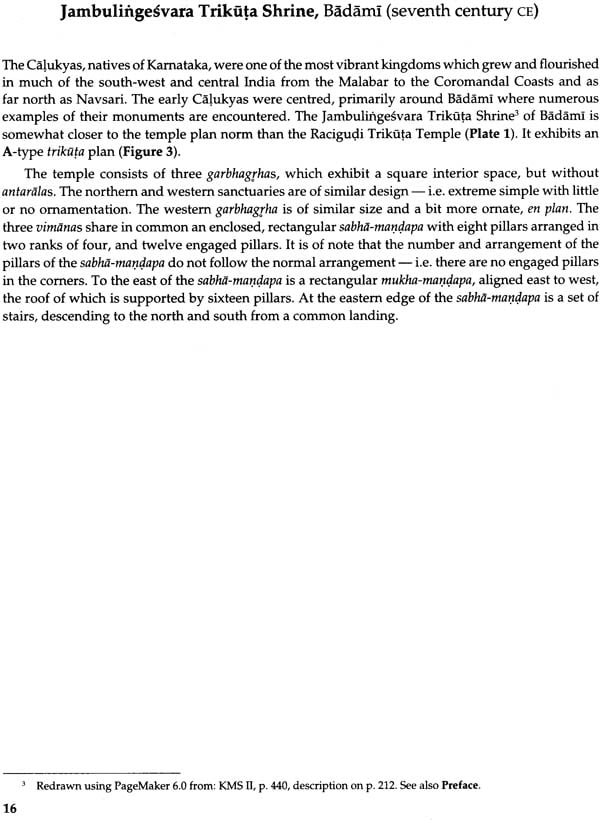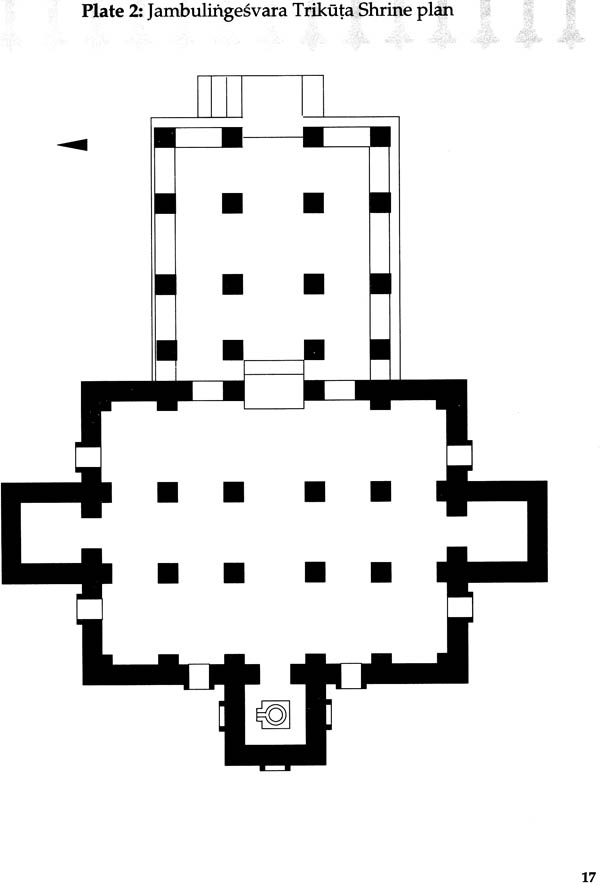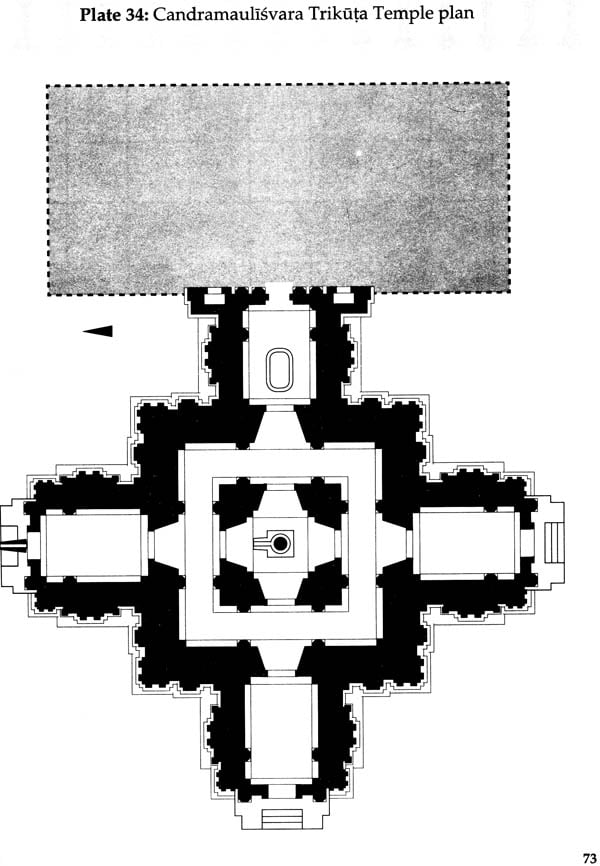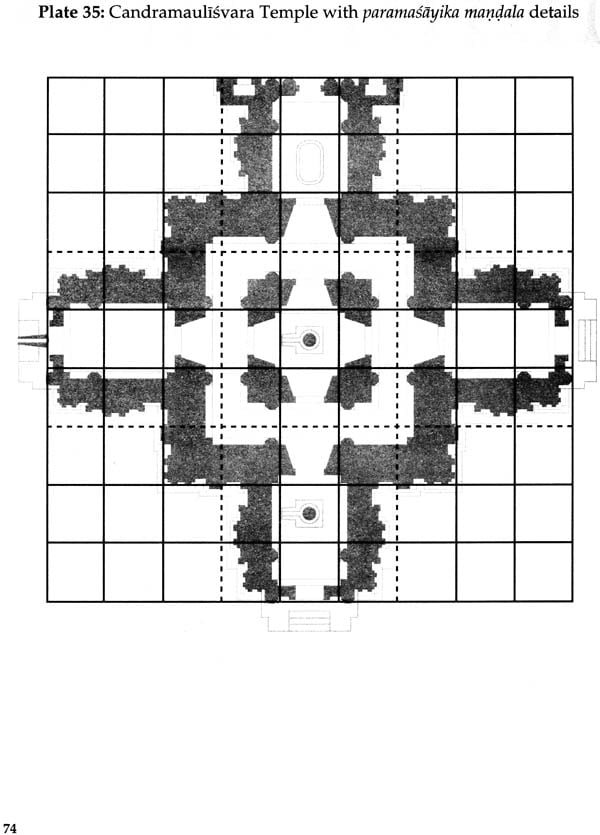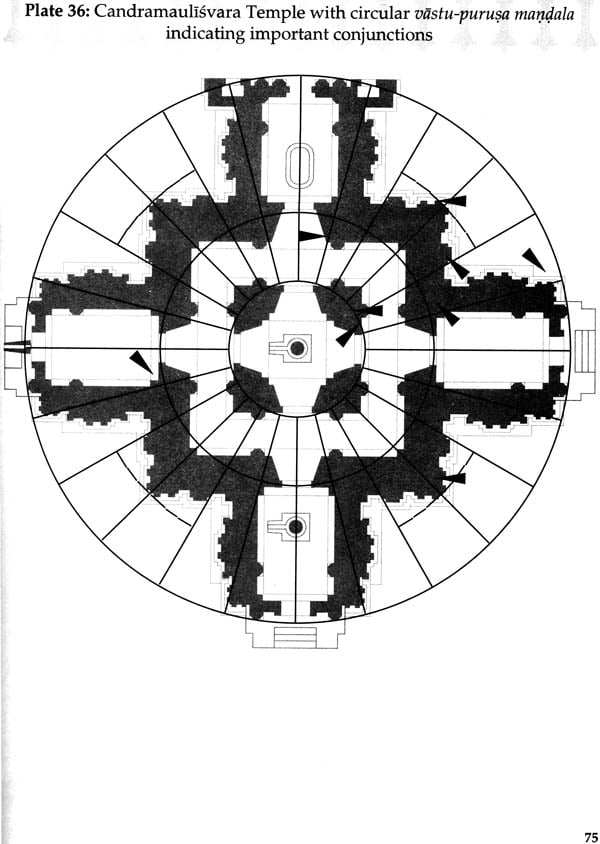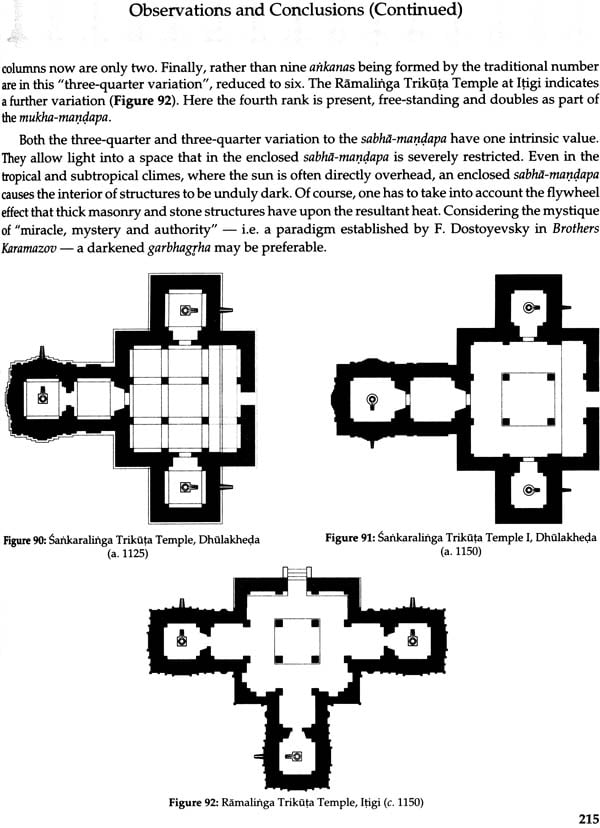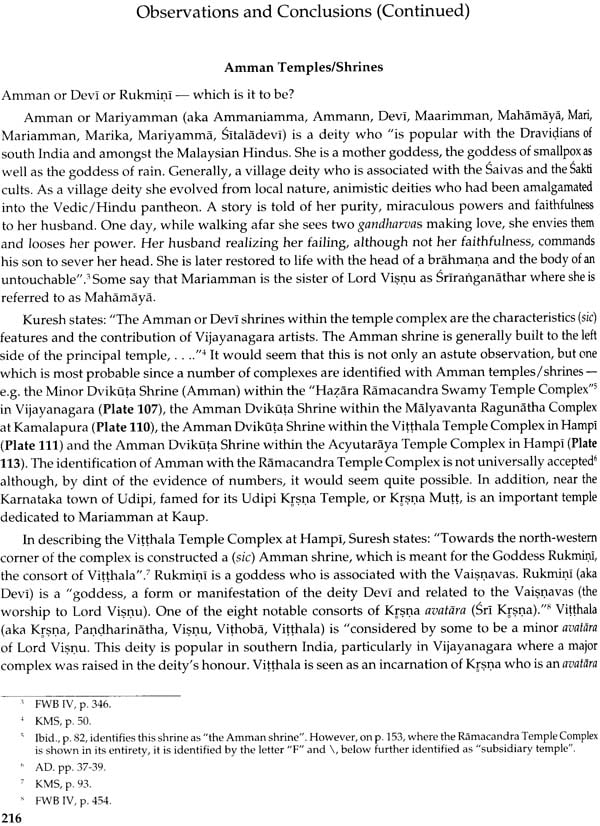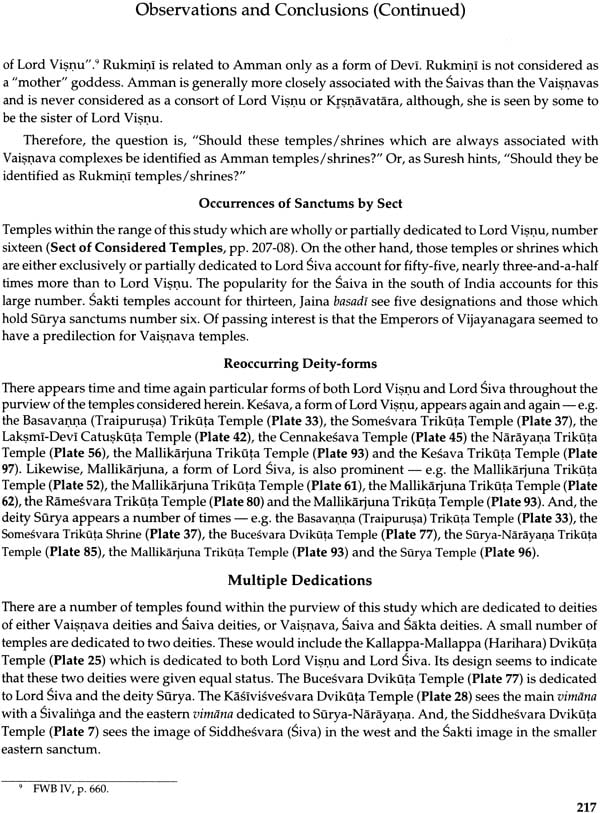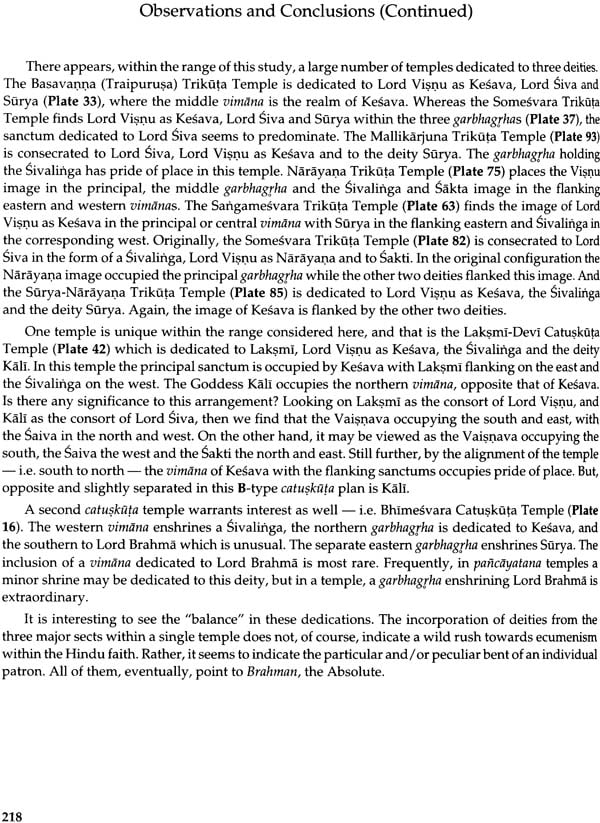
Temples with Multiple Garbhagrhas (An Iconographic Consideration of Selected Indian Monuments)
Book Specification
| Item Code: | NAF489 |
| Author: | Fredrick W. Bunce |
| Publisher: | D. K. Printworld Pvt. Ltd. |
| Language: | English |
| Edition: | 2014 |
| ISBN: | 9788124607251 |
| Pages: | 285 (Throughout B/W Illustrations) |
| Cover: | Hardcover |
| Other Details | 11.0 inch x 9.0 inch |
| Weight | 1.22 kg |
Book Description
Hindu temples are raised to their deities. They are a means to acknowledge the deity and to enshrine his/her images. People honour and worship the deity. Within the Hindu pantheon, there is an array of divinities spread over three major array of divinities spread over three major sects-vaisnava, saiva and sata. All these sects have stemmed from the Vedic teachings and beliefs. Normally a temple is devoted to a single deity, having a solitary sanctum (garbhagrha), called ekakuta. IN this volume the author, through his serious research, has made a sincere attempt to identify, present and feature about one hundred temples a with multiple garbhagrhas which are categorized as dvikuta, trikuta, catuskuta, pancakuta, saptakuta, navakuta and cunsath yogin temple.
This book delves deep into the details of these temples: their historical milieu, their iconography, the application f Mandala (s) to their plans and so on. It also attempts to correct those errors crept in the earlier studies of other researchers in understanding and detailing a few multiple garbhagrhas. The author has given brief description of such temples and has made a sincere effort to provide a relatively précis e scale rendering of those temples, in a size and format, commensurate with their importance.
This volume can serve architects, temple planners, researchers Vastu experts and even historians as a sourcebook on temples with multiple garbhagrhas.
Fredrick W. Bunce, a PhD and a cultural historian of international eminence, is an authority on ancient iconography and Buddhist arts. He has been honoured with prestigious awards/commendation and is listed in Who's who in American Art and The International Biographical Dictionary,1980. He is currently Professor Emeritus of Art, Indian State University , Terre Haute, Indian.
A Number of years ago my interest in iconography began to focus on plans, specifically plans of the temples of India and the Indianzed states. Over a period of time, I encountered temples which had more than one shrine or garbhagrha. I was first attracted to the Paya-Thon –Zu in Paga, Burma, and then found a number of others.
Recently, I became aware that there were few studies, if any that focused on temples with multiple garbhagrhas, so I undertook to gather together as many plans as possible revolving around this type of temple. I was able to identify well over one-hundred temples labeled as: dvikuta, trikuta catuskuta, pancakuta, navakuta and caunsath temples. Yet, there was a surprising dearth of plans published.
The majority of my endeavors revolve around the consideration of published plans. Many plans display a small component, a multipsantum shrine as a part of a larger complex. In this case, the redrawing of the plan-i.e. employing PageMaker 6.0- posed some problems particularly in the indication of specific details of the Plan. Indeed, some studies even feature temples or shrines with multiple garbhagrhas which are clear, and to scale. Most of the sources were exact. There were, unfortunately, exceptions.
The two studies of Suresh presented scores of plans and attendant descriptions. In this sense, these studies were a veritable gold mine of plans with multiple garghagrhas, even though there were obvious errors. The descriptions were through and were greatly appreciated, however, there were numerous errors throughout. These were noted in the footnotes of this considerate. Importantly, the sections displaying the various plans presented a number of plans which simply did not follow the descriptions or vice versa. They were not to scale! For example the description of the Durga The garbhagrha us square… ..”However, the plan of that temple found on p. 139, indicates a clearly rectangular garghagrha, approximately 1:1.5, and columns of the sabha-mandapa that are also rectangular. Immediately, I realized that the plans and elevations that Suresh had provided the publisher had been “widened” or distorted, obviously to conform more readily t the format of the page. This strange protraction of the height and elongation of the width appears on nearly every one of the pages 135-74. One particularly odd, even amusing plan is found on p. 150,KMS, in which the “Bala Krishna temple complex” is “squashed” down to two- thirds of its normal east-west configuration. The same holds true in KMS II. The plans on pages 321-490, of the second volume are also distorted in the same manner. If it weren’t for the through descriptions, the redrawing of the plans would have been impossible with any accuracy. For two such important books, this is an inexcusable error! With reference to the latter, every effort was made to translate these mutated plans to ones which were to scale, considering the obstacle. Any deviation herein from the scale of the original plans of these temples was unavoidable and any ensuing, inadvertent errors are admitted by this researcher.
Therefore, this consideration concentrates on temples which exhibit either dvikuta, or tirkuta, or catuskuta, or pancakuta, or navakuta, or caunsath types of plans.
Selected temples are considered in detail-i.e. their historical milieu, their iconography and the application of mandal (s) to the plan(s) are provided. IN addition, there also appears those multiple garbhagrha temples which are initially found to be flawed in both KMS and KMS II. They are included with a brief description, but their raison d’etre is to provide a relatively precise scale rendering of those temples and in a size and format commensurate with their importance.
It is hoped that the representation of these mutated plans in proper scale will be of benefit.
The Roman statesman Marcus Vispanius Agrippa had assumed the cost of building a temple called the Pantheon on the site where the present structure of the same name stands. It was destroyed by fire in CE. 80. Forty-five years later the Emperor Publius Aelius Traianus Hadrianus raised the present monument and retained the name Pantheon.
The pantheon represents a type of ecumenism that was practiced by the Roman state at that period. So as not to offend any of the major deities commonly worshipped at the time, it was dedicated to seven major Roman deities-i.e. the seven planets: Saturn Jupiter, Mars, Venus, Mercury, Diana (moon) and Apollo(sun). Their shrines were so placed as none had pride of place (Appendix A, Plate 67). Although, one might feel that the shrine opposite the entrance would assume major importance. The modern major religions-i.e. Christianity and Islam- were not faced with this dilemma since they were essentially monotheistic. Yet, the Christians flirted with the circular form on more than one occasion (Appendix A, Plates 68, 70) and not always with great success as tradition always placed the altar in the east. The Pantheon was, by virtue of its polytheistic character, a more successful solution, at east to the circle.
Whether vimana or prasada or stupa or viharan Buddhists, Hindus and Jainas raised monuments to the deities. They were constructed to acknowledge the deity. They were constructed to enshrine images of the deity. They were constructed so that the devotees might honor and worship the deity.
Compared to the numerous Roman deities, the Hindu pantheon is vast! This enormous array of divinities is spread over three major sects-i.e. Vaisnava , Saiva and Sakta. They are essentially disparate entities with little common ground other that they fall under the umbrella known as Hinduism and derive from Vedic beliefs. Whether Vaisnava, Saiva or sakta, the vast majority of India Hindu temples are exclusively dedicated to a single deity with a solitary sanctum (garbhagrha)-i.e. ekakuta . Even the trinity-lords Brahman, visnu and Siva –are more often than not worshipped as separate entities within their own temples. The forms (murti) of Lord Siva, the avatara of the Lord Visnu or the forms of the lady Devi are frequently worshipped within numerous single sanctum temples. The standard is a temple that often consists of a garbhagrha, antarala and mandapa. Jaina temples tend to vary somewhat from the Hindu standard, but their relationship to the Hindu faith is apparent. Within the Brahmaninc faith, the design of a temple, the construction of a individual sects. Yet there are a number of temples which display more than one sanctum where the cultic image is enshrined.
But, early in the development of hindu temple architecture there appears the pancayatna plan a complex in which the central temple is surrounded by four other shrines, frequently at the intercardinal point of the compass (Appendix A, Plate 71). Both the Dasavathara Temple (Gupta Temple) at Deogarh and the Avantisvami Temple of Avantipur indicate a quincunx arrangement. However, the quincunx arrangement clearly separates the four cardinal point shrines plan, from the central which the main difference was that the central shrine was raised higher than the other four (Appendix A, Plates 74-75). The traditional Indian pancayantana plan develops in such a way that the central shrine is clearly larger than the diminutive intercardinal shrines (Appendix A, Plates 76-68).
The Buddhists wrestled with the concept of equals amongst many, particularly the panca-buddhas –i.e. the Buddha Aksobhya,Buddha Amitabha, Buddha Amonghasiddhi, Buddha Ratnasambhava and Buddha vairocana. It was solved in the unique stupa dhamma-yazika at Pagan in a most novel manner and to a lesser degree in the Pentagonal Temple (Panca-Buddhas) also of Pagan (Appendix A, Plates 79-80). In these two monuments the central position is implied and remains the realm of The Absolute, the Adi-Buddha-i.e. in the case of stupa, it is the soaring spire and in the Pentagonal Temple (Panca-Buddhas) sikhara.
Although, as noted above, in the Hindu faith there was no elemental theological need or requirement to present a number of the pantheo on an equal footing. All deities were manifestations of Brahma-Sarasvati or Visnu-Lakshmi or Siva-Parvatiand they were manifestations of the Absolute One, Brahman. The trimurit of Hindusim did not suffer the same interpretational or presentational problems as the Cristain Trinity!.
Multiple Sanctums
Dvikuta: However, there were instncees in which tmples were constructed n which htwo sanctuaries, two sanctums, two garbhagrhas are to be found-i.e. a dvikuta temple. The simplest solution would seem sanctums, two garbhagrhas on the same axis (Figure 2 A). This particular resolution is encountered in a number of temples an dalthough the temple is named for one deity, two are honoured –e.g. the Kallappa-Mallappa (Harihara) Dvikuta Temple at Devaragennur (Plate 15). Herein, this will be identified as andA-type dvikuta temple. A second solution is seen in which the second garbhagrha is not placed on the same axis, but on a n axis that is 90, perpendicular axis (Figure 2B). This solution to the dvikuta temple is seen in the Devikuta Shrine o f he Ramacandra Temple Complex at Vijayanagara (Plate 54). Herein, this will be identified as B-type dvikuta temple. The B- type solution presents a temple that is essentially asymmetrical. Symmetry was not an absolute requirement for either the Buddhists or the Hindus. But, generally speaking, it was a design element that was highly sought and desired. There were a number of requirements that dealt with alignment of a temple to a point of the compass. These considerations may have entered into the asymmetrical alignment shown in fig. 2B. Further, there may be inferred a “pride-of –place” in either alignment. Generally, alignment towards the west is preferred, but not an absolute requirement, and alignment towards the north is preferred except the secondary garbhagrha does not possess an antarala (Fig2C.) The last of the dvikuta temple types is the D-type seen when two garbhagrhas are set side by side often sharing a common mandapa. This solution to the dvikuta temple may be seen in the saiva Dvikuta Temple at Chaudadampur (Plate 12). Herein, this will be identified as a D-type dvikuta temple (fig.2D).
Trikuta: When a third sanctum- i.e. a trikuta temple- enters the equation, three solutions appear inevitable –i.e. one in which two garbhagrhas are at right angles to the third and generally equidistant from the crossing (Fig 3A). Herein, this will be identified as an A-type trikuta temple. The kedaresvara Trikuta Temple (Plate 3A). Herein, this will be identified as an A-type trikuta temple. The kedaresara Tirkuta Temple (Plate 23) of Balagamve is representative of this –i.e. an A-type trikuta temple. There are a number of temples, particularly in the south, in which this solution is put into practice with pleasing results. A second variation is the B-type which is related to the A-type except the secondary garbhagrhas do not possess an antarala. The third solution is similar to the A-type-i.e. two snactums are on the same axis and the third is 90 to that axis and not equidistant to the crossing (fig 3C.). Herein, this will be identified as a C-type tikuta temple. An example of the C-type trikuta temple is encountered in the Trikutesvara Temple at Gadag (Plate 20). And, the last variation is seen when the sanctums are ranked,facing htesame direction and generally sharing a mandapa (Figure 3D). Herein , this will be identified a s D-type tikuta temple. An example of the D-type trikuta temple is seen in the Anatasayana Trikuta Temple at Navali (Plate 48) (Appendix C, Plate 129).
Catusjita: T he addition of a fourth sanctum creating a catuskuta temple is also a simple solution as seen in Figure 4A. In this solution, the four snactums all face inward, towards the crossing and are equidistant from that crossing. Herein, this will be identified as an A-type catuskuta temple. The only design problem in the catuskuta temple plan, A-type, is where is the entrance to be? Generally, it is placed beyond the crossing towards one of the sanctums. In so doing, that” arm” is generally extended to accommodate entrance (Figure 4B). Herein, this will be identified as a B-type cautskuta temple. There are no examples of type A, for obvious reasons. However, an example of a type B catuskuta temple is seen in the Lakshmi-Devi Catuskuta Temple of Dodda Gadduvalli (Plate 42).
Pancakuta: The addition of another, a fifth sanctuary-i.e. pancakuta-creates certain problems. A simple solution is to place a sanctum in the centre and two sanctums on either side and two more at 90. The four sanctums are equidistant from the centre shrine. Herein, this will be identified as an A-type pancakuta temple (figure 5A). This unique solution is found in the Siddhalingesvara Pancakuta Temple of Siruval (Plate 58). A second solution is similar, but he four surrounding shrines are rotated 45, on axis from the central sanctum. Herein, this will be identified as an A-type pancakuta temple (figure 5B). This solution is frequently encountered in the pancayatana plan noted above. However, the central shrine almost always predominates due ot its larger size and generally is not considered to be a true pancakuta temple (Laksmana Temple Ensemble, Khajuraho; Appendix C, Plate 126). However, this solution presents a problem. If the construction of a pancakuta is undertaken in order to give all five deities an equal status, then the shrine in the centre, by pride of place, assumes prominence, and, therefore, less than satisfactory. The Khmer, in their quincunx design (Figure 5B), clearly gave precedent to the central shrine, not only because of its location, but also due to he fact that this shrine was frequently elevated above the other four (Appendix A, Plates 122-123). The Theravadists of Pagan, as mentioned, solved this problem in a most unique way. They constructed five shrines, the centre axis of each was shifted 72 one from the other(figure 6 [left]). The Dhamma –Yazika with its five Pagan (a.CE 1175)(Figure 6 [left]) is les satisfactory due to its crude execution, but the same solution, none the less (Appendix A, Plates 127-128). A third solution, unique to the subcontinent, is where the temples are paced in a row-i.e. side by side (figure 5C). Herein, this will be identified as aC-type pancakuta tmeplae. An example f the C-type pancakuta temple is seen in the Pnacalingesvara Pnacakuta Temple at Govindanahalli (Plate 90).
Saskuta: A temple with six shrines or sanctums-i.e. saskuta-colud have at least two design solutions regarding the arrangement, although there are no examples in the subcontinent. One in which the shrines or sanctums are aligned to the cardinal points of the compass, much in same way as the pancayatana plan (figure 7 [left0). A second possible solution which is related to the Pagan solution, indicated above, is that in which the axis of each temple is rotated 60 (figure 7 [right]).
Saptakuta: Seven shrines or sanctums-i.e. saptakuta-offer a much different solution. The kailasanatha Temple (Plate 5) of kancipuram in Tamil Ndau, offers one possible solution. There, six of the seven exterior shrines are aligned along the northern and southern sides of the vimana, three on each side, the seventh is centered on the western side (figure 8[ldft]). A solution is derived from the Hindu pancayatana plan (Figure 8 [centre]). Another solution is possible in which the axis of each of the temples is rotated 51.428 (Figure 8 [right]), an adaptaion of the Pagan solution noted above. However, the Kailasaatha Temple of Bennikllur. T he solution encountered here is so eccentric, so erratic as to seen as a temple in which the chapels or sanctums were added haphazardly over a period o f time and can only be called saptakuta due to the number of chapels.
Examples of an ekakuta, dvikuta and tikuta temples abound in the subcontinent. Catuskuta, pancakuta as well as saptakta andnavakuta temples find examples, although, far less frequently solutions to the design of a temple with eight shrines or sanctums-i.e. astakuta-could be seen to be adaptations to either the Pagan solution (Figure 9[right]) or the Hindu pancayatana plan (figure 9 [left]). It must be noted however, that although the inclusion of eight sanctums is a possibility, there are no examples to be found in India.
Navakuta: A temple of nine shrines r sanctums –i.e. navakuta-might well follow similar possible solutions-i.e. an adaptation of the Hindu pancayatana plan (Figure 10[left]) or the Pagan solution (Figure 10 [right]). One may assert a that the kailasanatha Temple (Figure 11[left]) may also be seen to be navakuta as there are nine shrines –i.e. seven exterior and two interior shrines. This arrangement presents a fairly workable solution. However, the Navalinga Nabakuta Temple of Kukanur, Karnataka, presents a truly eccentric plan (Figure 11 [right, Plate 69). There, it appears that a variation of Hindu pancayatana plan (Figure 11) us subverted. One shrine-i.e. the lower right shrine (Figure11). This solution doubles was achieved, not during a single construction process, but, over a number of years in which it was deemed meritorious by some devotee to add a shrine to the complex. If nothing else, the solution of the Navalinga Navakuta Temple is interesting although a bit unusual, maybe even haphazard!
The above enumeration, particularly the dvikuta,trikuta, catuskuta, pancakuta, saptakuta and nvakuta find examples more or less throughout India. There is one further temple type which exhibits multiple sanctums or chapel and that is the Causath (Caunsath)Yogin Temples-i.e. a temple with sixty-four shrines (Figure 12). These circular, hypaethral temples are found in the west central region of the subcontinent. They are dedicated to the sixty-four yoginis and in some cases the Sapta-Matrkas are added. The Caunsath Yogin Mandire of Bheraghat (Plate 38) possesses eight –one capels and the Caunsath Yogini Temple of Hirapur (Plate 3) and the Caunsath Temple of Ranipur-Jharial (Appemdox C, Plate 131) both have sixty-four shrines. In addition, there exists a little known temple in Mitaoli, Madhya Pradesh, known as Ekottaso Mahadeva Mandir or the Caunsath Yogin Mandr. Rather than dedicated to the yogini, it is dedicated to the Lord Siva and displays sixty-four lingas in shallow shrines with a large Sivalinga in a central shrine (Appendix C, Plate 132).
Ekakuta, dvikuta, trikuta,ctuskuta and pancakuta all may be considered orthodox, en plan. Navakuta and caunsath-kuta, because of their rarity, may appear to be some w hat heterodox, particularly the Navlinga Navakuta Temple.
| Preface | v |
| List of Plates | xi |
| List of Figures | xvii |
| Abbreviations | xxi |
| Introduction | 1 |
| Selected Temples in India with Multiple Garbhagrhas (Shrines) | 13 |
| Racigudi Tirkuta Temple, Aihole | 14 |
| Jambulingesvara Trikuta Shrine, Badami | 16 |
| Caunsath Yogini Temple, Hirapur | 18 |
| Candragupta Trikuta Basadi, Sravanabelagola | 20 |
| Kailasanatha Temple, Kancipuram | 22 |
| Siddhevara Dvikuta Temple, Algodu | 26 |
| Jaina (Trikuta) Basadin NO. 15, Deogarh | 28 |
| Vaidyanathesevara Dvikuta Tmeple,Vaidyanathapura | 32 |
| Gangadharesvara Dvikuta Temple, Doddaisvara | 34 |
| Saiva Dvikuta Temple, chaudadampur | 36 |
| Caunsath Yogini Sanctuary, Khajuraho | 38 |
| Kallesvara Dvikuta Temple, Bagali | 40 |
| Jaina Tirthankara Trikuta Basadi, Arasibedi | 42 |
| Bhimesvara Catukuta Temples, Nillagunda | 44 |
| Mahadeva Trikuta Temples, Balagamve | 48 |
| Trikutesvara Temple, Gadag | 50 |
| Kedaresvara Trikuta Temple, Balagamve | 54 |
| Kallappa-Mallappa (Harihara ) Dvikuta Temple, Devaragennur | 58 |
| Kasivisvesvara Dvikuta Temple. Lakkundi | 62 |
| Ramesvara Trikuta Temple, Yaragal | 66 |
| Isvara Trikuta Temple, Basarakody | 68 |
| Basavnna (Traipurusa) Trikuta Tmple, Malhghana | 70 |
| Candramaulisvara Temple, Unkal | 72 |
| Somesvara Trikuta Temple, Kabali | 76 |
| Caunsath YogininMandir and Gauir Sankar Temple, Bheraghat | 78 |
| Somesvara Trikuta Temple, Haralhalli, Karnataka | 80 |
| Laksmi-Devi Catuskuta Temple, Dodda Gadduvalli | 84 |
| Trikutesvara Trikuta Temple, Belur | 88 |
| Cennakesava Temple, Belur | 90 |
| Anantasayana Trikuta Temple, Navali | 94 |
| Hoysalesvara Dvikuta Temple, Halebid | 96 |
| Mallikarjuna Trikuta Temple, Dhulakheda | 100 |
| Ramesvara Dvikuta Temple, Yaragal | 102 |
| Sankaralinga Trikuta Temple, Dhulakeda | 104 |
| Ramallinga Dvikuta Temple, Sirur | 106 |
| Narayan Trikuta Temple, Anekannambadi | 108 |
| Siddhalingesvara Pancakuta Temple, Siruvala | 112 |
| Mallikarjuna Trikuta Temple, Katnahalli | 116 |
| Mallikarjuna Trikuta Temple, Hospet | 118 |
| Sangamesvara Dvikuta Temple, Horti | 120 |
| Ramalinga Dvikuta Temple, Horti | 124 |
| Kote Sankaralinga Dvikuta Temple, Nimbal | 126 |
| Sambhulinga Dviukuta Temple, Kakklameli | 128 |
| Kalideva Dvikuta Temple, Kummsi | 130 |
| Sankaralinga Dvikuta Temple, Kalakere | 134 |
| Sangamesvarea Trikuta Temple, Babalesvara | 138 |
| Ramalinga Trikuta Temple, Itigi | 140 |
| Narayana Trikuta Temple, ngalesvara | 142 |
| Ramaligesvara Trikuta Temple, Kundaragi | 144 |
| Bucesvara Dvikuta Temple, Loravangala | 146 |
| Ramesvara Trikuta Shrine, Kurugod | 150 |
| Basti or Kalla-Gidi Trikuta Temple, Degamve | 152 |
| Somesvara Trikuta Temple, Ingalesvara | 154 |
| Parmanaanda Triuta Temple, Konnur | 156 |
| Viranarayana Trikuta Temple, Belvadi | 158 |
| Surya-Narayana Tikuta Temple, Mugala | 160 |
| Isvara Dvikuta Temple, Arsikere | 162 |
| Laksmi-Narasimha Trikuta Temple, Bhjadravati | 164 |
| Pancalingesvara Pancakuta Temple, Govindananhalli | 168 |
| Mallikarjuna Trikuta Temple, Basaralu | 172 |
| Surya Temple, konarka | 176 |
| Kesava Trikuta Temple, Somanthapur | 178 |
| Saiva Dviluta Temple, Hampi | 182 |
| Kampilaraya Trikuta Temple (Nol.1), Hampi | 184 |
| Kampilaraya Trikuta Temple (No. 3), Ham mpi | 188 |
| Minor Dvikuta Shrine (Amman), Vijayanagara | 192 |
| Kunthu Junanatha Dvikuta Jinalaya, Kamalapura | 194 |
| Parsvanatha Dvikuta Jinalaya, Hampi | 196 |
| Amman Dvikuta Temple Malyavantha Raghunatha Complex, Kamalapura | 198 |
| Amman Dvikuta Shrine, Vitthala Temple Complex, Hampi | 200 |
| Candrasekhara Dvikuta temple, Hamip | 202 |
| Amman Dvikuta Shrine, Acyutaraya Temple Complex, Hampi | 204 |
| Trikutesvara (Siva) Temple, Timmalapur | 206 |
| Observations and Conclusions | 208 |
| Sect of Considered Temples | 219 |
| Appendices | 221 |
| A: Glossary and Application of Terms | 222 |
| B: List of Dvikuta, Trikuta, Catuksuta, Pancakuta, Saptakuta, Navakuta and Caunsath Temples | 235 |
| C: Miscellaneous Plans and Elevations | 239 |
| D: Relevant Ruling Dynasties | 267 |
| Bibliography | 283 |
